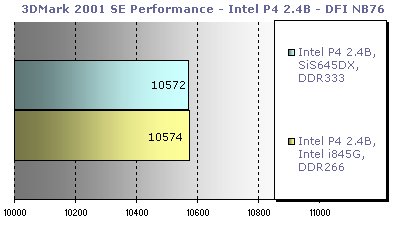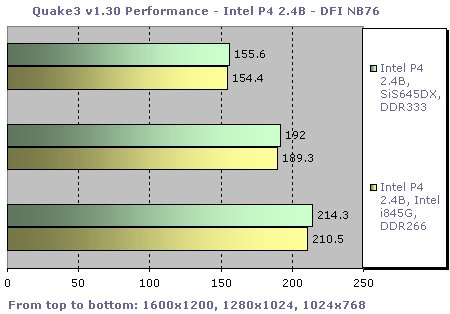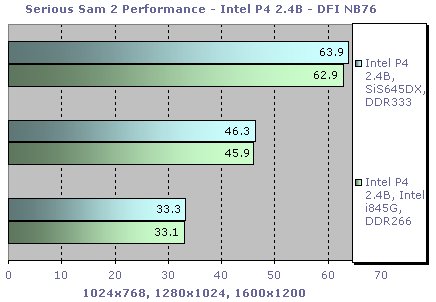|
You'll notice straight away that there are no numbers from the Intel onboard graphics on the GMCH in any of these 3D benchmarks. I'll leave GMCH graphics commentary until the end of the look at overall performance. Until then, the numbers you'll see are done using Ti4400 on the two testbeds, SiS645 in DDR333 mode and the Intel i845G on the test DFI NB76 in DDR266 more.
First off, 3DMark 2001. If you've followed our reviews at Hexus before you'll know that 3DMark 2001 is a DirectX 8 benchmark that relies on strong system performance in a number of areas for a good score. CPU performance, memory bandwith and the GPU under the hood all have an affect on performance to some extent. Let's see how the NB76/i845G stacks up to 654E/645DX using the same CPU, GPU and driver combo.

2 marks in it, even after the averages were taken (see the page before this one for an explanation) shows that chipset isn't the deciding factor here and more specifically memory bandwidth. Despite i845G having less available system memory bandwith than SiS 645DX (DDR266 vs DDR333), the systems exhibited identical 3DMark 2001 DX8 performance. Quite an achievement. 105xx out of the box from 2.4B, DDR and Ti4400 indicates masses of 3D performance from the work go from i845G.
Lets see how that maps to Quake3. Remembering from previous encounters with the iD Software classic, we know that maybe memory bandwidth does have an affect on performance here.

The extra memory bandwidth has an effect at the lower resolution of 1024x768. With Quake3, the lower the resolution, the more the system performance is a factor rather than graphics card performance. As we move up the graph towards the higher resolution, we can see that the bandwidth that i845G loses against 645DX matters little the performance is essentially identical. Overall, identical real world performance from both chipsets and so far the DFI is doing well.
Serious Sam: The Second Encounter should show broadly similar performance here, comparable to what we've seen already. Expect the SiS board to take the honours.

The graph is inverted resolution wise compared to the Q3 graph above, with the lower resolutions on top this time. SiS 645DX takes the honours here but no so you'd notice. The extra bandwidth helps in lower resolutions and all resolutions played well on the test setup. i845G gives very little the the flagship SiS chipset and in the real world the difference is close to nothing.
So a quick look at 3D performance so far shows the DFI doing extremely well compared to the MSI board using the SiS chipset and we can see the solid Intel AGP implementation hasn't been lost in the transition to the GMCH. Next up we'll continue our look at 3D performance and move on to some media work.
|